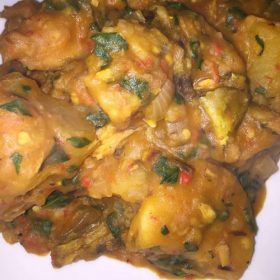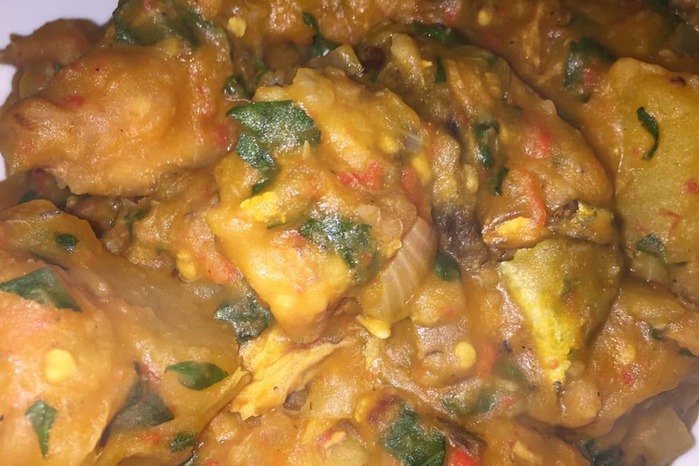Nigerian Food
How to Make Achicha Ede (Cocoyam Pottage) – Echicha Ede
How to Make Achicha Ede (Cocoyam Pottage)
Contents
Food is an intricate part of every culture. Understanding the food choices and practices of a group of people gives one an opportunity to understand their cultural, social, philosophical and religion practices.
Achicha Ede is a traditional dish of cocoyam potage which originates from the Igbo region of Nigeria particularly Enugu. Cassavas and yams are culturally important to the Igbos and thus appear predominantly in most of their cuisines.
Enugu, translated as ‘the top of a hill’ is one of the states located in the eastern part of Nigeria. The state is known for its rich culture which is showcased in the traditional attires, festivals and cultural dishes native to that area. The state is also known for its delicious palm wine.
Achicha Ede is made from dried cocoyam flakes. The cocoyam is usually harvested in dry season and then is then cooked and sun dried or smoked to get rid of its water content. When properly spiced, this dish is very tasty. It is usually eaten on its own but can be enjoyed in combination with Fio-Fio (pigeon pea).
Pigeon pea know scientifically as Cajanus cajan is a leguminous crop grown for its edible seeds. The plant survives easily and can also thrive in harsh conditions. It is stored by air drying and can be kept for an extended time period. It is a good source of protein and dietary fibre. It also contains high amounts of vitamins, thiamine, copper, magnesium, potassium, phosphorus and manganese. They are also rich in antioxidants and other unique compounds.

How to Make Achicha Ede
AchichaEde is a traditional dish of cocoyam potage which originates from the Igboregion of Nigeria particularly Enugu.
Ingredients
- 1 bunch Chopped Pumpkin Leaves
- 2 cups Dried Cocoyam Flakes
- 2 cups Fio-Fio (pigeon peas)
- 2 mid-size Dryfish (pieced)
- 4 oz Palm Oil
- 1 bunch Chopped Scent Leaves
- ½ cup Ukpaka (ugba)
- 2 bulbs Onions Chopped
- 6 large Fresh Red Peppers Chopped
- 1 tbsp Dry Pepper
- 2 cubes Seasoning Maggi/Knorr Cubes
- 1 tbsp Ground Crayfish
Instructions
Put the dry cocoyam in a mortar, crush itwith a pestle and then soak the crushed cocoyam overnight in clean water.
Lay the pigeon pea in a tray and select dirtoff it. When the pigeon pea is clean, rinse and cook on medium heat.
Rinse the soaked cocoyam properly to removesand. Put in filter and drain the water off it.
Wrap the cocoyam in a clean nylon and putthem gently into the pot of boiling pigeon peas. Cook for 20mins or more untilboth the peas and cocoyam are tender. You may need to add more water to preventthem from burning.
Once they are tender, switch off the heatand set aside.
Put a clean pan on fire. Add palm oil and adjustto low heat.
Add the onion and fresh pepper, fry for 2minutes.
Add Ukpaka, pieced dry fish and crayfish,stir gently. Simmer for 5 mins.
Add dry pepper, salt and seasoning cubes.
Transfer the content of the pan (sauce)into the pot containing the tender cocoyam and pigeon peas.
Add the diced scent leaves and pumpkinleaves. Stir gently with a wooden spoon and simmer for 5mins on low heat.
Your Achicha Ede is ready. Serve hot.
Recipe Notes
Achicha Ede when combined with Fio-Fio (pigeon pea) holds great nutritional and health benefits.
In fact, the seeds of Fio-Fio are known to have great health benefits. The potassium contained in them serves as a vasodilator when consumed. This helps to reduce the constriction of blood vessels thereby aiding in lowering blood pressure and reducing the risk of cardiovascular diseases. Also, pigeon pea paste is used traditionally as a remedy for pile.
Again, its protein content is important for healing of wounds, regeneration of cells, growth and development, as they are a building block for cells, tissues, muscles and bones. Study shows that a single cup of boiled pigeon peas contains 11 grams of protein.
Pigeon pea has a significant amount of folate. A deficiency of folate in the body is associated to a number of health challenges like; anemia and certain neural tube defects seen in unborn children. A single cup of pigeon pea can provide over 110% of the daily recommended folate intake. This legume therefore helps to prevent anemia.
The seeds of pigeon peas are very low in saturated fats and cholesterol. Its high fibre content increases your metabolism. This prevents you from gaining unhealthy weight. It also contains Niacin and Riboflavin which actively enhances the metabolism of carbohydrates and prevents the storage of fat, thereby enriching the body with a constant flow of energy.
Freshly harvested uncooked Pigeon peas is also a good source of vitamin C. vitamin C stimulates the production of white blood cells in the body to fight off infections, thereby boosting the overall immune system.

